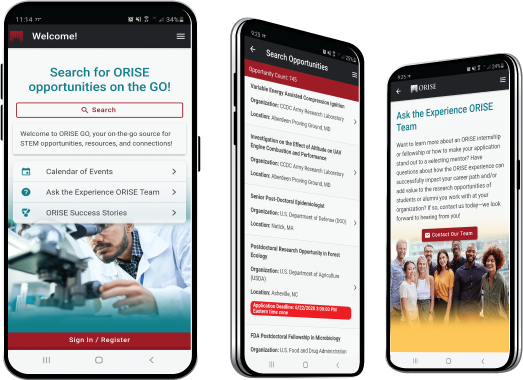Specific and Precise Individual-Scale Contact Tracing of Infectious Diseases
Create and release your Profile on Zintellect – Postdoctoral applicants must create an account and complete a profile in the on-line application system. Please note: your resume/CV may not exceed 2 pages.
Complete your application – Enter the rest of the information required for the IC Postdoc Program Research Opportunity. The application itself contains detailed instructions for each one of these components: availability, citizenship, transcripts, dissertation abstract, publication and presentation plan, and information about your Research Advisor co-applicant.
Additional information about the IC Postdoctoral Research Fellowship Program is available on the program website located at: https://orise.orau.gov/icpostdoc/index.html.
If you have questions, send an email to ICPostdoc@orau.org. Please include the reference code for this opportunity in your email.
Research Topic Description, including Problem Statement:
Near real-time whole-genome sequencing of emerging pathogens has become possible in the last decade through the combination of high-throughput next generation sequencing, world-wide connectivity to the internet, and low-cost cloud computing and storage. This new global capability to collect and share massive amounts of pathogen data has been effectively demonstrated with the COVID-19 outbreak. Within the first two weeks following reporting of the potential outbreak in Wuhan multiple whole-genomes of the virus were available online. In the months since, thousands of viral genomes have been sequenced and made publicly available. This massive quantity of genetic data has enabled and driven global research activities at a pace never realized during any previous pandemic. This availability of data has also led to new capabilities to track virus transmission and movement at a country and regional scale. Tools, such as NextStrain, have demonstrated such abilities to compare different genomes and map mutations, enabling the prediction of viral species and variants between countries and continents. While many of these modeling processes are effective at regional or country scales, they often fail to accurately model individual-to-individual transmission due to the limited number of directly correlated sequences and the transient state of mutations associated with wide-scale transmission. The goal of research associated with this topic should focus on improved understanding of these individual-to-individual mutations across a population and the bioinformatics and software tools for modeling and even predicting these changes.
Example Approaches:
As referenced in the topic paragraph, NextStrain and similar approaches have leveraged data predominately from clinical human samples. While these clinical samples align with the public health need, they are not ideal for a controlled research activity within the IC Postdoc program due to the numerous uncontrolled variables associated with such samples, increased costs, and PII/IRB requirements often associated with collecting or storing these type of samples. Additionally, approaches and models should be extensible outside of just transmission within individuals of the same species to include other intra- and inter-species transmission modeling. As such, some alternative approaches to study this phenomenon would include models leveraging laboratory transmission studies for well-controlled environments or samples collected from zoonotic or domestic animals.
Relevance to the Intelligence Community:
Retrospective analysis of genomic data associated with infectious spread has provided insight towards attribution and timeline. For example, a limited number of criminal cases have used molecular analysis of HIV to corroborate the intentional spread from one individual to another of the virus. Building upon this retrospective and individualistic approach, approaches which can dive deeper than a regional or even city level could better inform the IC on potential transmission mechanism (natural or intentional spread), transmission rate (super spreader events), and potentially transmission routes (air, ground, or sea). Advances aligning to some or all of these information spaces, via real time analysis, would improve the IC’s biosecurity and biodefense stance when dealing with future biological events.
Key Words: Infectious Disease, Contract Tracing, Next Generation Sequencing, Forensics, Individual-to-Individual Transmission
Postdoc Eligibility
- U.S. citizens only
- Ph.D. in a relevant field must be completed before beginning the appointment and within five years of the application deadline
- Proposal must be associated with an accredited U.S. university, college, or U.S. government laboratory
- Eligible candidates may only receive one award from the IC Postdoctoral Research Fellowship Program
Research Advisor Eligibility
- Must be an employee of an accredited U.S. university, college or U.S. government laboratory
- Are not required to be U.S. citizens
- Citizenship: U.S. Citizen Only
- Degree: Doctoral Degree.
-
Discipline(s):
- Chemistry and Materials Sciences (12 )
- Communications and Graphics Design (2 )
- Computer, Information, and Data Sciences (16 )
- Earth and Geosciences (21 )
- Engineering (27 )
- Environmental and Marine Sciences (14 )
- Life Health and Medical Sciences (45 )
- Mathematics and Statistics (10 )
- Other Non-Science & Engineering (2 )
- Physics (16 )
- Science & Engineering-related (1 )
- Social and Behavioral Sciences (27 )

 ORISE GO
ORISE GO

The ORISE GO mobile app helps you stay engaged, connected and informed during your ORISE experience – from application, to offer, through your appointment and even as an ORISE alum!





